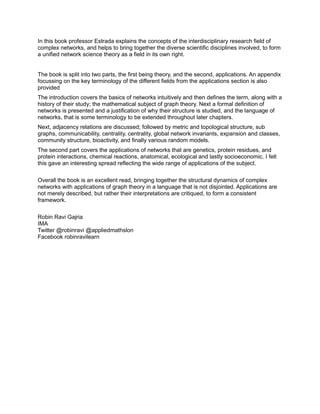Robin ravi gajria ima mathematics today review 7 the structure of complex networks
- 1. In this book professor Estrada explains the concepts of the interdisciplinary research field of complex networks, and helps to bring together the diverse scientific disciplines involved, to form a unified network science theory as a field in its own right. The book is split into two parts, the first being theory, and the second, applications. An appendix focussing on the key terminology of the different fields from the applications section is also provided The introduction covers the basics of networks intuitively and then defines the term, along with a history of their study; the mathematical subject of graph theory. Next a formal definition of networks is presented and a justification of why their structure is studied, and the language of networks, that is some terminology to be extended throughout later chapters. Next, adjacency relations are discussed; followed by metric and topological structure, sub graphs, communicability, centrality, centrality, global network invariants, expansion and classes, community structure, bioactivity, and finally various random models. The second part covers the applications of networks that are genetics, protein residues, and protein interactions, chemical reactions, anatomical, ecological and lastly socioeconomic. I felt this gave an interesting spread reflecting the wide range of applications of the subject. Overall the book is an excellent read, bringing together the structural dynamics of complex networks with applications of graph theory in a language that is not disjointed. Applications are not merely described, but rather their interpretations are critiqued, to form a consistent framework. Robin Ravi Gajria IMA Twitter @robinravi @appliedmathslon Facebook robinravilearn

